Gluten-free crescent rolls bring back a warm, buttery kind of memory I didn’t know I missed until I started baking them myself. As a kid, I’d hover around the oven, nose in the air, waiting for that golden crescent to be pulled out and brushed with melted butter. Back then, we didn’t know much about gluten or food allergies—bread was just something that made every meal feel complete.
Today, for anyone with celiac or gluten sensitivity—or those simply choosing a cleaner path—those comforting moments are still within reach. This guide is your go-to for baking gluten-free crescent rolls that are soft, flaky, and full of nostalgic flavor. Whether you’re crafting them from scratch or curious about store-bought options, this article covers every angle.
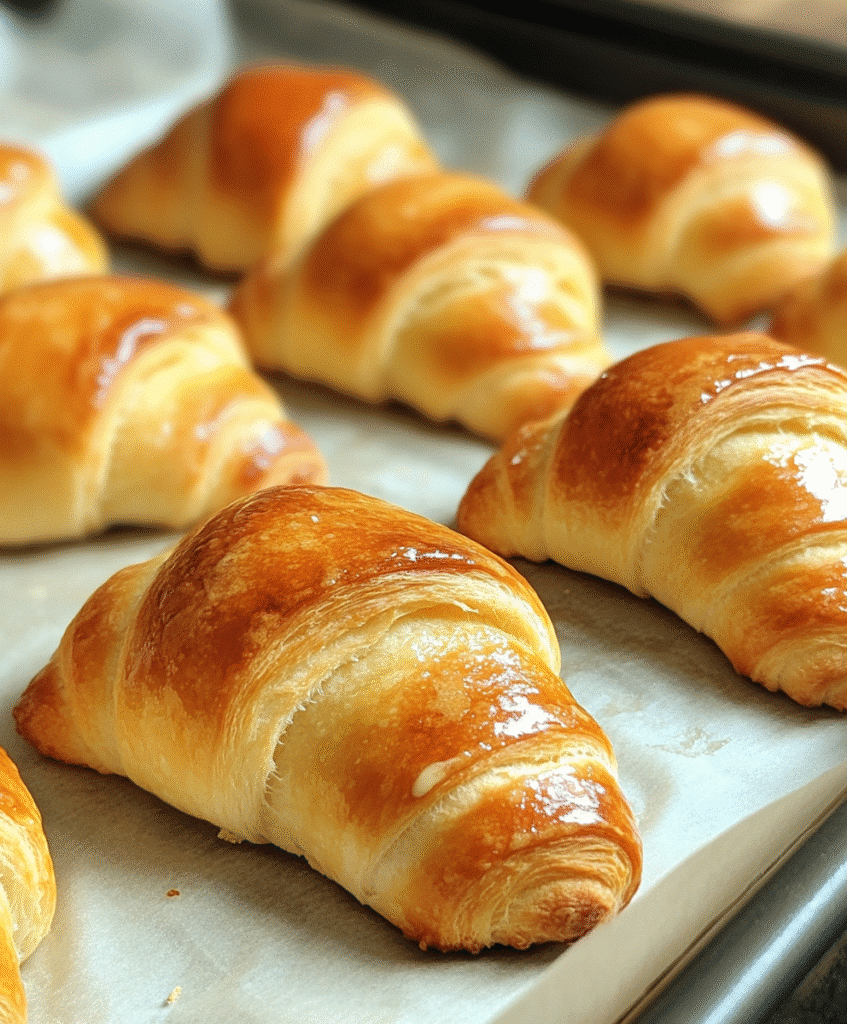
We’ll walk through ingredients, step-by-step instructions, baking tips, and creative twists for both sweet and savory variations. You’ll also find pro tips on freezing, reheating, and adapting your dough to fit other gluten-free recipes.
Discover great ideas like our gluten-free creamy chicken casserole and let’s make your kitchen smell like buttery joy—minus the gluten.
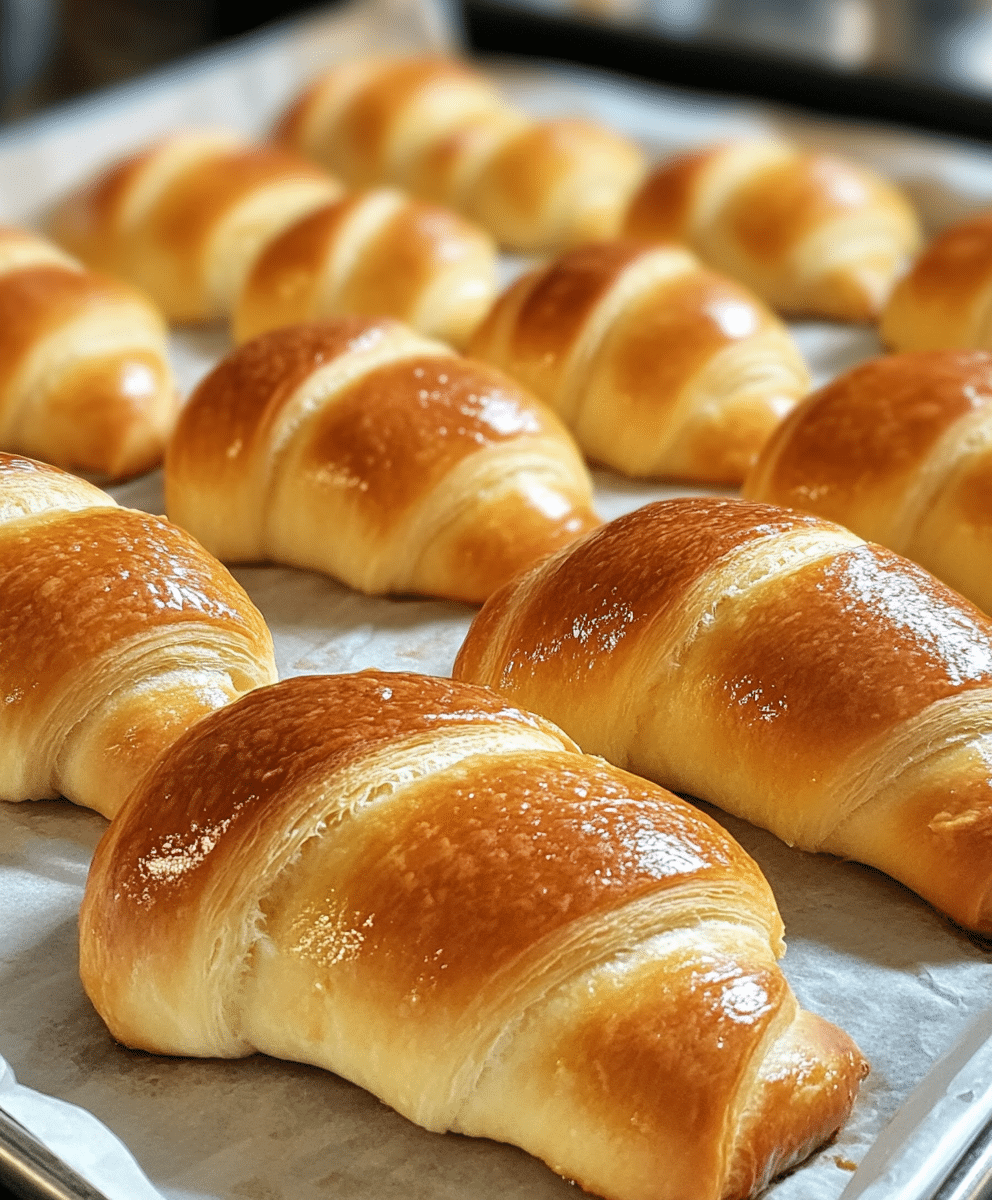
Gluten-Free Crescent Rolls
Ingredients
Equipment
Method
- In a large bowl, whisk together gluten-free flour, psyllium husk, yeast, baking powder, sugar, and salt.
- Add cubed cold butter and cut into flour until the texture is crumbly.
- In another bowl, whisk egg and milk together.
- Pour wet mixture into the dry and mix just until combined—don’t overmix.
- Cover and let dough rest for 30 minutes.
- On a floured surface, roll out dough into a ¼-inch thick circle.
- Cut into triangles and roll each one up from the wide end.
- Place rolls on a parchment-lined baking sheet and let rise for 1 hour.
- Bake at 375°F for 15–20 minutes until golden brown.
- Remove from oven and brush immediately with melted butter.
Nutrition
Notes
- For best results, use a gluten-free flour blend that includes xanthan gum. If your blend doesn’t, add 1 tsp of xanthan gum per 2 cups of flour.
- Cold butter is essential for creating flaky layers. Avoid melting or softening it before cutting it into the flour.
- Make sure your milk is lukewarm—not hot—to avoid killing the yeast.
- You can prepare the dough ahead of time and refrigerate it overnight. Let it come to room temperature before shaping and baking.
- To freeze: Shape rolls and freeze before baking. Let them thaw and rise at room temperature before placing in the oven.
- Brush freshly baked rolls with melted butter to keep them soft and enhance flavor.
- This dough is also great for mini pizzas, sweet rolls, and savory stuffed crescents!
Tried this recipe?
Let us know how it was!Table of Contents
Table of Contents
Why Gluten-Free Crescent Rolls Are a Must-Try
Understanding Gluten Sensitivities & the Demand for Alternatives
The demand for gluten-free baking has skyrocketed, and with good reason. From celiac disease to mild gluten intolerance, more households are swapping traditional wheat flour for alternatives. And yet, giving up comforting baked goods—especially crescent rolls—feels like too big a trade-off.
That’s why gluten-free crescent rolls are such a win. They offer the soft, golden layers you remember without the ingredients your body rejects. This isn’t just about a bread substitute—it’s about preserving tradition, flavor, and joy at the dinner table.
Why Crescent Rolls are Loved (Even More When Gluten-Free!)
Crescent rolls hold a special place at holidays and family meals. They’re buttery, warm, and flaky, and now they can be made completely gluten-free without missing a beat. When done right, gluten-free crescent rolls:
- Taste just as rich as the original version
- Work with both savory fillings and sweet spreads
- Keep well in the fridge or freezer for meal prep
From brunch to dinner, these rolls are the perfect side or snack. Don’t miss our gluten-free dinner rolls for another soft-baked option.
Up next, we’ll take a close look at the ingredients that bring these golden crescents to life.
Ingredients Breakdown for the Best Gluten-Free Crescent Rolls
Top Recommended Gluten-Free Flours & Why They Work
The secret to flaky, light gluten-free crescent rolls starts with the right flour blend. Not all gluten-free flours are created equal—and when it comes to baking with yeast, texture is everything.
Here are top-performing flours that rise, stretch, and brown like traditional wheat-based dough:
| Gluten-Free Flour Blend | Why It Works |
|---|---|
| Better Batter | Contains xanthan gum and is specifically formulated for yeast recipes. Great chew and rise. |
| Pillsbury Gluten-Free | Balanced blend that produces soft dough and doesn’t crumble after baking. |
| Cup4Cup | High protein content and includes milk powder for structure and softness. |
| King Arthur Gluten-Free Baking Mix | Easily available and blends well with psyllium husk for elasticity. |
Each of these blends mimics the protein structure of gluten when combined with binders like xanthan gum or psyllium husk—crucial for creating that traditional roll texture.
Pro Tip: Always check if your flour includes binders like xanthan gum. If not, you’ll need to add it manually.
Role of Psyllium Husk & Xanthan Gum in the Dough
When baking gluten-free, think of psyllium husk and xanthan gum as your dough’s best friends.
- Psyllium Husk Powder: This plant-based fiber forms a gel when mixed with water, creating structure and stretch in your dough. It also helps lock in moisture, preventing the rolls from drying out after baking.
- Xanthan Gum: Acts like gluten—it binds ingredients together and supports the dough’s rise. Just a teaspoon can drastically improve your roll’s elasticity and texture.
Used together, these ingredients create a dough that’s strong enough to roll, rise, and bake into the classic crescent shape without falling apart.
If you want to master gluten-free baking, don’t skip the binders. You can see similar applications in our gluten-free roux recipe, where structure and thickness matter just as much.
Step-by-Step Gluten-Free Crescent Roll Recipe Guide
Making the Dough: From Mixing to Resting
There’s nothing quite like the satisfaction of making gluten-free crescent rolls from scratch. The process is easier than you’d think—and the reward is warm, golden crescents that melt in your mouth. Let’s walk through it, step by step.
- Combine Your Dry Ingredients
Start with a large bowl and whisk together:- 2 cups gluten-free flour blend (Pillsbury or Better Batter recommended)
- 1 tbsp psyllium husk powder
- 1 tsp xanthan gum (only if not already in your flour blend)
- 1 tsp instant yeast
- 1 tsp baking powder
- 1 tsp sugar
- 1 tsp salt
This mixture forms the foundation for your gluten-free crescent rolls—creating rise, chew, and softness all in one.
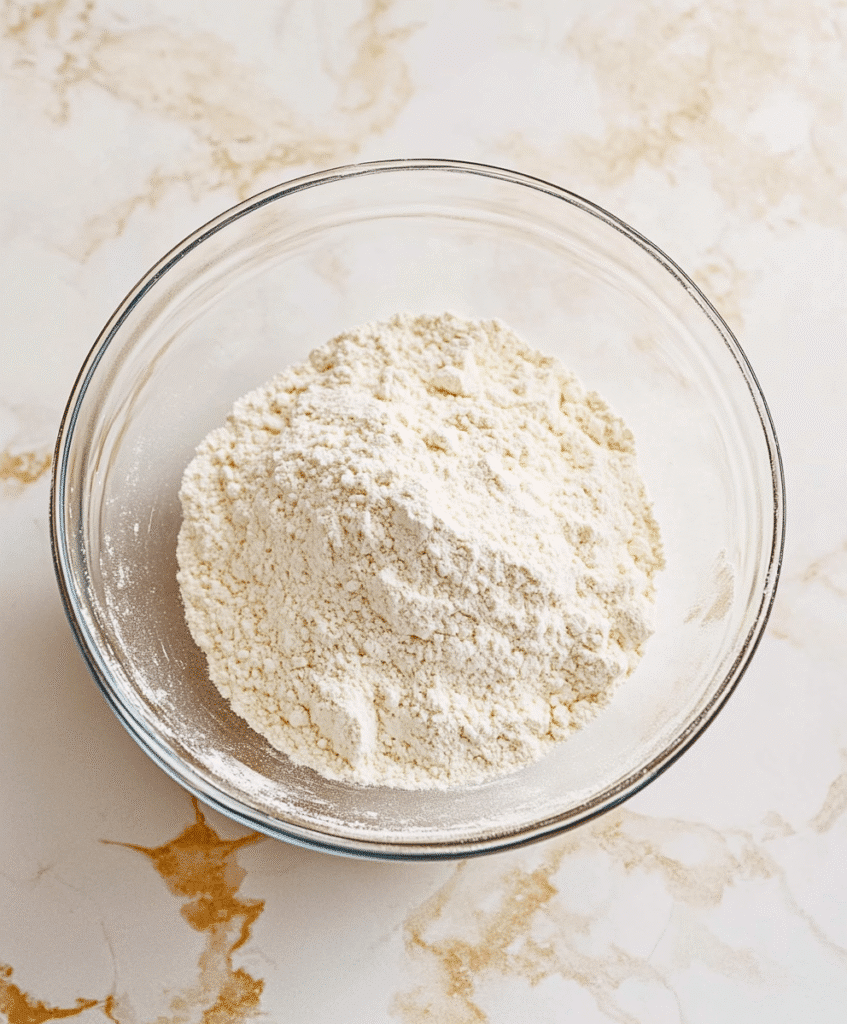
- Cut in the Butter for Flaky Layers
Add ¼ cup of cold, cubed unsalted butter. Using a pastry cutter or your hands, work it into the dry ingredients until the texture is crumbly and the butter is evenly distributed. This step is key for flaky gluten-free crescent rolls. - Add the Wet Ingredients
In another bowl, whisk:- 1 large egg (room temp)
- ⅔ cup lukewarm milk
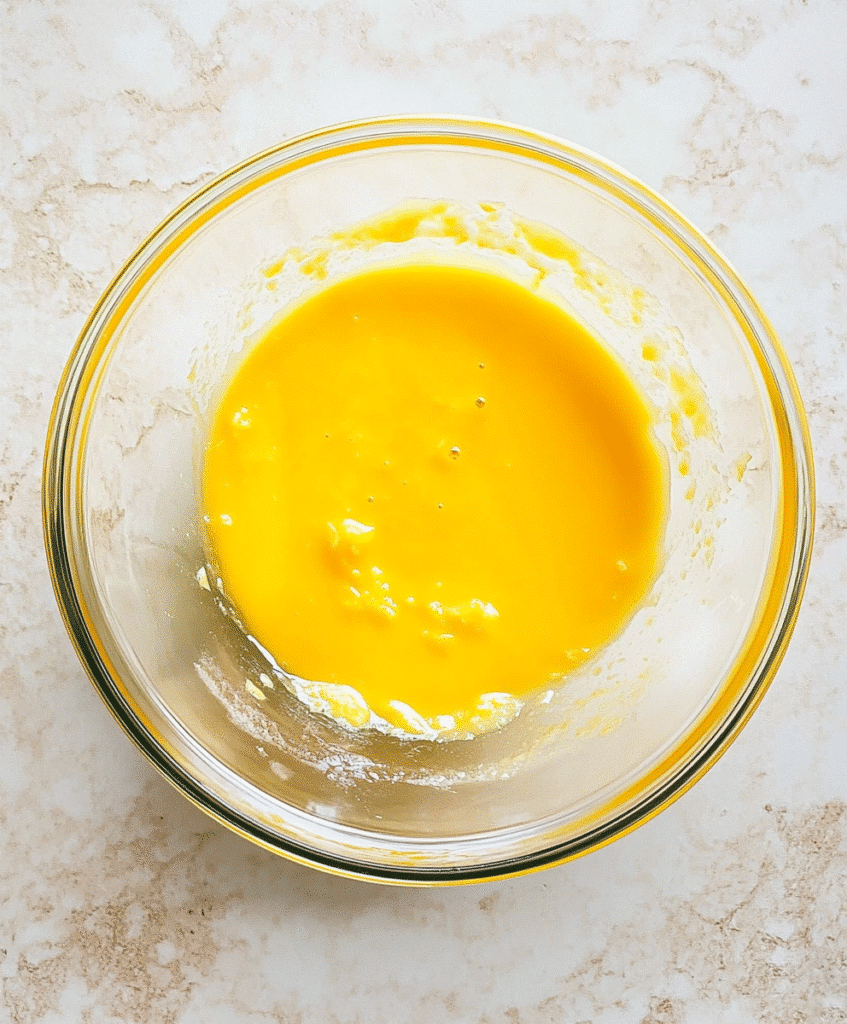
Gently combine the wet with the dry, stirring just until a soft dough forms. Don’t overmix—keeping it tender is what gives gluten-free crescent rolls that pull-apart softness.
- Let the Dough Rest
Cover the bowl with plastic wrap and let it sit for 30 minutes in a warm spot. This rest allows the yeast to activate and the dough to become easier to shape.
Pro Tip: If the dough feels too dry, add 1 tablespoon of milk. Too sticky? Add a teaspoon of flour at a time.
Looking for more structure-building tips in gluten-free baking? Don’t miss our guide on how to make a gluten-free roux.
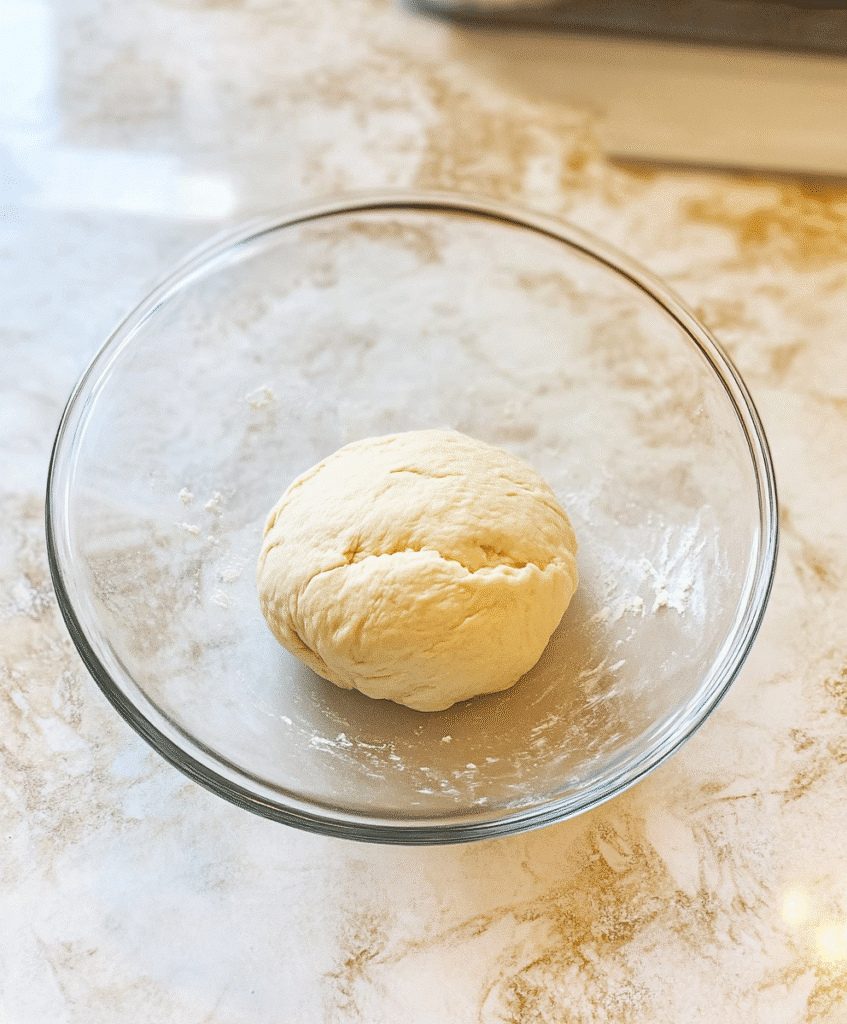
Shaping the Rolls: Rolling & Proofing for Fluffiness
Now let’s bring those classic gluten-free crescent rolls to life.
- Roll It Out
On a lightly floured surface, roll the dough into a circle about ¼ inch thick. Smooth edges make prettier crescents. - Slice and Shape
Using a pizza cutter or sharp knife, cut the dough into 8–12 equal triangles. Roll each one up from the wide end toward the tip. Place the rolled gluten-free crescent rolls on a parchment-lined baking sheet. - Let Them Rise
Cover the tray lightly and let your crescent rolls rise for 1 hour. This second proofing makes them soft and fluffy, just like the classic version—only better for your gut. - Bake to Golden Perfection
Preheat your oven to 375°F. Bake the gluten-free crescent rolls for 15–20 minutes or until they’re golden brown and puffed. Brush with melted butter the moment they come out for that irresistible glow.
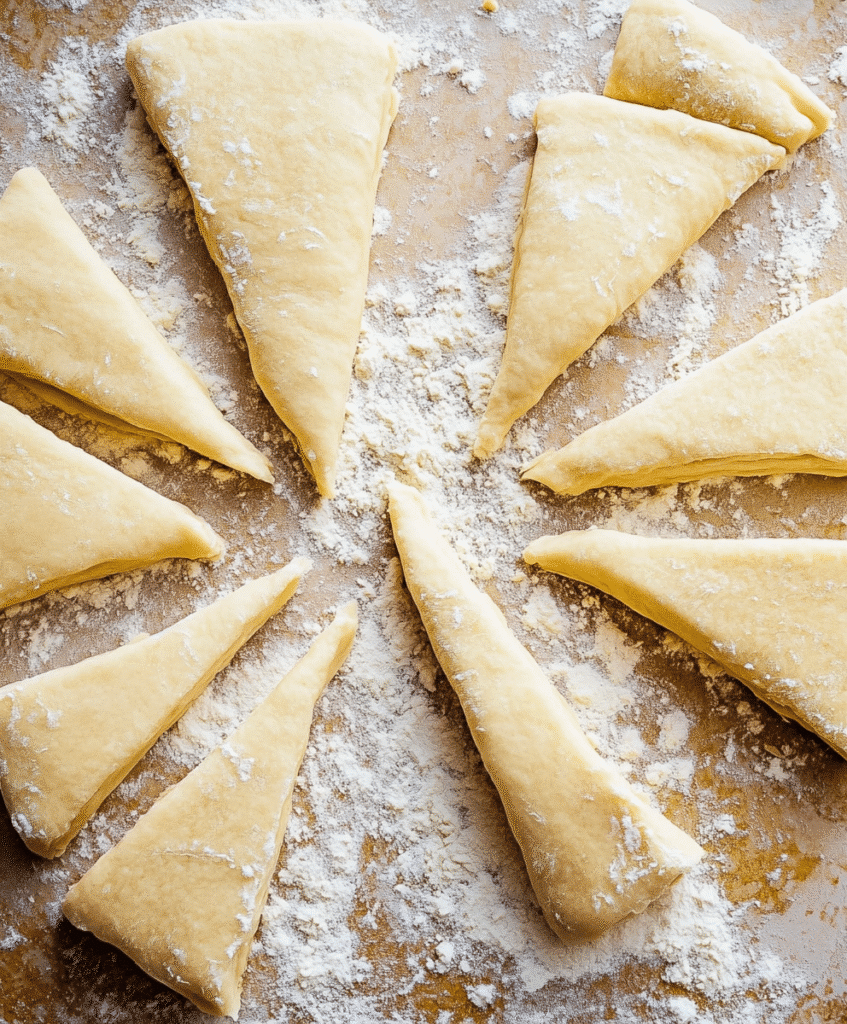
Whether you’re making a holiday spread or just a feel-good weekend treat, these gluten-free crescent rolls are destined to impress. Want to pair them with something creamy and savory? Check out our gluten-free creamy chicken casserole for the perfect match.
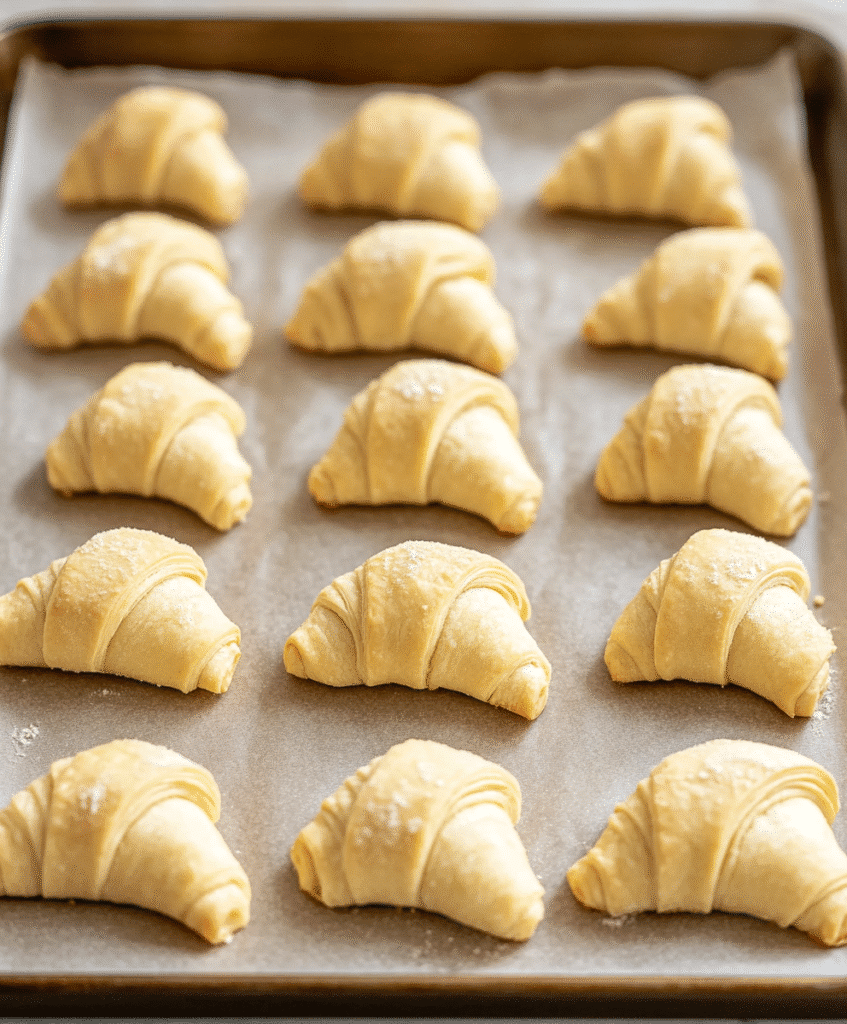
Baking Tips for Perfect Golden Crescent Rolls
Oven Temps, Baking Time & Color Indicators
You’ve shaped your gluten-free crescent rolls and let them rise—now it’s time to get that bakery-level finish.
Start by preheating your oven to 375°F (190°C). Unlike traditional wheat-based dough, gluten-free doughs are more sensitive to both temperature and moisture, so consistency is key.
Bake Time:
- Bake for 15 to 20 minutes on the middle rack.
- Look for golden tops and lightly crisp bottoms.
- The ideal roll should feel firm to the touch but give slightly when pressed.
Color Cues:
If your gluten-free crescent rolls are underbaked, they’ll be pale with a doughy center. Overbaking? They’ll turn hard and dry. Aim for a deep golden color on the peaks and edges.
Pro Tip: Rotate your tray halfway through baking to ensure even browning.
How to Avoid Common Gluten-Free Baking Mistakes
Even seasoned bakers can run into hiccups with gluten-free dough. Let’s tackle the most common issues so your gluten-free crescent rolls turn out perfect every time.
| Problem | Cause | Fix |
|---|---|---|
| Dough too sticky | Overhydrated or under-mixed | Add GF flour 1 tsp at a time |
| Rolls didn’t rise | Yeast was old or water too hot | Use fresh yeast + lukewarm milk |
| Rolls are dry and crumbly | Not enough fat or moisture | Check your egg, butter, and milk ratios |
| Gummy centers | Underbaked or oven too cool | Extend bake time by 2–3 mins & check temp |
And don’t skip that final buttery touch. As soon as your gluten-free crescent rolls are out of the oven, brush them with melted butter to lock in moisture and add shine.
Looking for inspiration? Try our gluten-free potato salad as a side for these crescent rolls—you’ll have a full meal with gluten-free greatness in every bite.

Creative Ways to Use Gluten-Free Crescent Dough
Mini Pizzas, Cinnamon Rolls & Other Tasty Twists
One of the best things about gluten-free crescent rolls? The dough is super versatile. Once you’ve nailed the base recipe, the sky’s the limit on how you can use it. Whether you’re in the mood for sweet, savory, or something in between, this dough bends to your cravings.
Here are some delicious ways to reinvent your crescent roll dough:
- Gluten-Free Mini Pizzas
Roll your dough into small circles, top with sauce, mozzarella, and your favorite toppings. Bake at 375°F for 10–12 minutes. Fast, fun, and family-friendly. - Crescent Cinnamon Rolls
Spread softened butter, brown sugar, and cinnamon across your rolled-out dough. Roll it up jelly-roll style, slice into rounds, and bake for 15–18 minutes. Add a cream cheese glaze for a bakery-style finish. - Cheesy Stuffed Crescents
Tuck a cube of cheddar, mozzarella, or dairy-free cheese inside each triangle before rolling. The cheese melts during baking for gooey, irresistible rolls. - Savory Herb Knots
Twist strips of dough into knots and brush with garlic butter, rosemary, and parmesan. Perfect with pasta or soups. - Fruit-Filled Crescents
Spoon jam or fresh fruit compote into the center before rolling up. Dust with powdered sugar or drizzle with a glaze once baked.
Pro Tip: Always seal edges tightly when filling crescents—especially with cheeses or fruit—so nothing leaks during baking.
These creative uses make gluten-free crescent rolls more than just a holiday side. They become a year-round staple for quick dinners, brunches, snacks, or party platters.
Want a perfect dessert to serve with sweet crescent rolls? Don’t miss our gluten-free coconut cream pie—it’s rich, smooth, and pairs beautifully with a fruit-filled crescent roll.
Making Savory vs Sweet Fillings
When it comes to customizing your crescent rolls, you can go bold with flavor. Here’s how to tailor your fillings:
| Type | Sweet Ideas | Savory Ideas |
|---|---|---|
| Dairy-Based | Cream cheese + jam | Cheddar + bacon crumbles |
| Fruit-Based | Apple pie filling | Sun-dried tomatoes + olives |
| Veggie-Based | Cinnamon pumpkin puree | Spinach + vegan feta |
Whether you’re creating handheld treats or fancy appetizers, this dough is your canvas—and the options for gluten-free crescent rolls are endless.
Storage, Freezing, and Reheating Tips
How to Keep Rolls Fresh Longer
Homemade gluten-free crescent rolls are best when served fresh out of the oven—but that doesn’t mean you can’t enjoy them days later. Gluten-free baked goods tend to dry out faster than wheat-based ones, so how you store them makes all the difference.
Room Temperature Storage (1–2 days):
- Store rolls in an airtight container or resealable plastic bag.
- Place a paper towel inside to absorb excess moisture.
- Avoid refrigerating unless absolutely necessary—it can dry them out faster.
Refrigeration (up to 4–5 days):
- Wrap rolls in foil or parchment, then store in a sealed container.
- Warm slightly in the microwave or oven before serving to revive softness.
Pro Tip: Brushing the rolls with a little melted butter before reheating brings back that fresh-baked flavor.
Freezing Raw vs Baked Crescent Rolls
Freezing is a great way to meal-prep your gluten-free crescent rolls in advance, especially during busy holiday seasons.
| Method | Instructions | Shelf Life |
|---|---|---|
| Freeze Before Baking | After shaping, place uncooked rolls on a baking sheet and freeze until solid. Then transfer to a freezer bag. | Up to 2 months |
| Freeze After Baking | Cool rolls completely. Wrap individually or place in freezer-safe container. | Up to 3 months |
Reheating Instructions:
- From Frozen (Unbaked): Let thaw and rise at room temp for 1–2 hours. Then bake as usual.
- From Frozen (Baked): Wrap in foil and reheat in a 350°F oven for 8–10 minutes.
Don’t forget, if you’re planning a brunch spread or a big dinner, you can also prep the dough ahead. Simply refrigerate the raw dough (covered) overnight and shape the next day.
Check out our gluten-free dinner rolls if you’re looking to prep multiple types of bread ahead of time—perfect for crowds.
Best Brands That Sell Gluten-Free Crescent Rolls
Store-Bought Options & How They Compare to Homemade
If you’re short on time or not ready to bake from scratch, you might be wondering: Can I buy gluten-free crescent rolls at the store? The good news? Yes, a few options do exist—but they’re not all created equal.
Here are some popular store-bought options that aim to deliver the same flakiness and flavor as homemade:
| Brand | Features | Notes |
|---|---|---|
| Immaculate Baking Co. | Gluten-free crescent-style dough, no artificial flavors | Only available at select retailers |
| Cybeles Free to Eat | Allergy-friendly and gluten-free | Mostly found online or in specialty health stores |
| Wholly Gluten Free | Rolls available frozen; dairy-free and nut-free | Great texture, but limited availability |
While these brands offer convenience, most fall short of the buttery layers and tender interior you get with homemade gluten-free crescent rolls. If you have dietary restrictions beyond gluten, check the label—some commercial options may contain dairy, soy, or egg.
Also, don’t expect these brands to match the clean ingredient list you control in your own kitchen. If taste and texture matter most to you (and they should), your best bet is still a fresh-baked batch using our recipe above.
Discover more feel-good homemade treats in our gluten-free creamy chicken casserole—a perfect match for your rolls on a cozy dinner night.
Are Pillsbury Crescent Rolls Gluten-Free? The Truth
This question comes up a lot, and unfortunately, the answer is no—Pillsbury Crescent Rolls are not gluten-free.
As of now, Pillsbury has not released a certified gluten-free crescent dough. While they offer some gluten-free baking mixes, their classic crescent roll dough still contains wheat flour and other gluten-containing ingredients.
For those who grew up loving Pillsbury crescents (I mean, who didn’t pop that can as a kid?), it can feel like a letdown. But the homemade version we’ve covered is a delicious replacement—flaky, buttery, and 100% gluten-free.
And the best part? No preservatives or additives—just clean ingredients and full control over what goes into your dough.
Want a nostalgic dessert to follow your gluten-free meal? Try our gluten-free banana pudding for another childhood favorite made better for sensitive diets.
Healthy Swaps & Allergen-Free Alternatives
Egg-Free, Dairy-Free & Vegan Crescent Dough Tips
One of the best things about making your own gluten-free crescent rolls is the flexibility to customize them to match your lifestyle. Whether you’re dealing with food allergies or following a vegan diet, these rolls can easily be modified without sacrificing texture or taste.
Dairy-Free Substitutes:
- Butter Swap: Use vegan butter like Earth Balance or Miyoko’s Creamery. Stick-style options work best for rolling into the dough.
- Milk Alternatives: Unsweetened almond, oat, or soy milk are great substitutes for dairy milk. Make sure the milk is lukewarm to activate the yeast properly.
Egg-Free Substitutes:
- Flax Egg: Mix 1 tablespoon of ground flaxseed with 3 tablespoons of water. Let it sit for 5–10 minutes to thicken.
- Aquafaba: Use 3 tablespoons of chickpea brine (from canned beans) to replace 1 egg. It’s light and mimics egg whites well.
Vegan Bonus Tip: Use both swaps above and double-check that your flour blend is egg- and dairy-free.
These allergen-friendly swaps allow anyone to enjoy gluten-free crescent rolls—even those avoiding top allergens. And they still come out soft, fluffy, and golden.
Nut-Free Options for Sensitive Diets
While most gluten-free crescent rolls are naturally nut-free, it’s important to be cautious with:
- Gluten-free flour blends that use almond flour as a base
- Plant-based milks like almond or cashew milk
Safe Nut-Free Choices:
- Use oat milk or rice milk instead of almond milk
- Choose nut-free flour blends like King Arthur or Better Batter (check labels)
If cross-contamination is a concern, always go for certified nut-free products when sourcing ingredients. And of course, keep those ingredient labels close.
By making a few simple swaps, you can share these gluten-free crescent rolls with just about anyone—regardless of dietary needs. That’s what real comfort food should do.
Serving Suggestions for Every Occasion
Holiday Meals: Thanksgiving, Christmas, Easter Ideas
There’s something about a basket of warm, buttery gluten-free crescent rolls sitting at the center of the holiday table that brings everyone together—food allergies or not. These rolls are a showstopper side for every major celebration.
Here’s how to serve them during the holidays:
- Thanksgiving: Pair your crescent rolls with turkey, gluten-free stuffing, and cranberry sauce. Add herb butter or garlic-infused olive oil on the side for dipping.
- Christmas Dinner: Serve alongside roasted ham, glazed carrots, and a rich gravy. Add a few rolls to your breadbasket with cinnamon-honey butter.
- Easter Brunch: Use your crescent dough to make mini pinwheels filled with ham and dairy-free cheese or serve them plain with strawberry preserves.
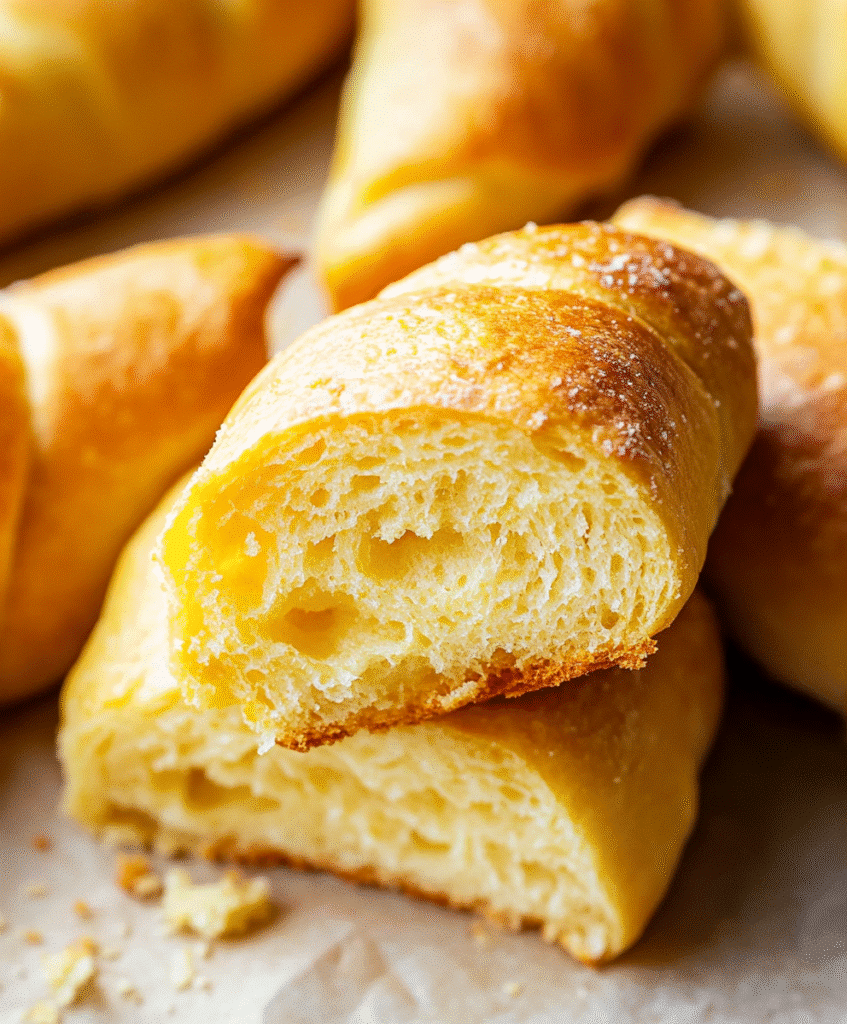
Everyday Pairings: What Goes Best With Gluten-Free Rolls
Even outside of holidays, these gluten-free crescent rolls make a killer addition to everyday meals. Their light, flaky texture complements just about anything, from hearty soups to fresh salads.
Weeknight Pairings:
- With soup: Serve rolls warm with a bowl of gluten-free tomato bisque or creamy potato leek soup.
- With pasta: Perfect for scooping up sauce from lasagna or baked ziti.
- With salad: Pair with a crisp Caesar or garden salad for a light lunch or dinner.
Leftover Ideas:
- Use them to make mini sandwiches or sliders the next day.
- Slice and toast slightly for gluten-free croutons or breakfast toast with jam.
And if you’re planning a picnic or potluck, wrap a few crescent rolls in foil and tuck them into your basket. They travel well and always get compliments.
Need one more savory dish to balance out your table? Don’t miss our gluten-free creamy chicken casserole—the ultimate comfort combo with warm rolls.
Conclusion: Gluten-Free Crescent Rolls That Truly Satisfy
Whether you’re preparing for a holiday feast, hosting a brunch, or just craving a little homemade comfort, these gluten-free crescent rolls deliver the flaky, buttery bite you’ve been missing. They’re easy to customize, allergy-friendly, and—best of all—made from real ingredients you can trust.
From understanding the perfect flour blend to rolling, shaping, baking, and even freezing, we’ve covered every angle to make sure your crescent rolls turn out bakery-worthy every single time.
The bonus? You don’t have to settle for less when living gluten-free.
Follow us on Facebook & Pinterest for more gluten-free dessert ideas and community fun!
FAQ: Gluten-Free Crescent Rolls – Your Questions Answered
Is there a company that makes gluten-free crescent rolls?
Yes, a few companies have stepped up to fill the gap in the market. Brands like Immaculate Baking Co. and Wholly Gluten Free offer crescent-style doughs that are certified gluten-free. While they’re not as widely available as traditional options, you can usually find them at specialty grocery stores or online. That said, many people prefer homemade gluten-free crescent rolls for better flavor, freshness, and control over ingredients.
Is there such a thing as gluten-free crescent rolls?
Absolutely! Gluten-free crescent rolls are real, and they’re delicious. Whether you bake them from scratch using a custom gluten-free flour blend or buy pre-made dough, there are plenty of options out there. Homemade versions tend to have better texture and fewer additives, especially when made with psyllium husk and xanthan gum for structure.
Do Pillsbury Crescent Rolls have gluten?
Yes, Pillsbury Crescent Rolls do contain gluten. They are made with traditional wheat flour and are not safe for people with celiac disease or gluten sensitivity. If you’re looking for that same flaky, buttery experience without the gluten, try our homemade recipe—it’s a game changer and just as satisfying as the store-bought classic.
What is a substitute for crescent roll dough?
If you’re out of crescent dough or need a substitute for dietary reasons, you’ve got options. Puff pastry (gluten-free, of course) can work in some recipes, although it’s lighter and flakier. For savory dishes, gluten-free biscuit dough or pizza dough can stand in. But when it comes to getting that perfect buttery, layered texture, nothing beats homemade gluten-free crescent rolls using our step-by-step guide.
